
Stenotus is a genus of flowering plants in the family Asteraceae. There are four species, all native to western North America. They are known commonly as mock goldenweeds.

Tonestus, common name serpentweed, is a genus of North American flowering plants in the family Asteraceae.
Lessingia virgata is a species of flowering plant in the family Asteraceae known by the common name wand lessingia. It is endemic to California, where it is known from the eastern side of the Central Valley and adjacent Sierra Nevada foothills. It is a woolly, glandular annual herb growing up to about 60 centimeters tall with slender, spreading branches. The upper leaves are no more than a centimeter long, while the lower ones are longer and sometimes divided into lobes or teeth. The flower heads appear singly in leaf axils, each lined with purple-tipped, glandular, woolly phyllaries. The head is discoid, containing no ray florets but a few tubular light lavender to nearly white disc florets with long, narrow lobes. The fruit is an achene with a whitish pappus on top.
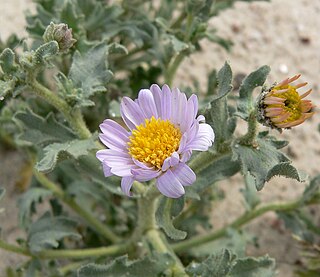
Leucosyris arida is an annual plant in the family Asteraceae, known by the common names arid tansyaster, desert tansyaster, and Silver Lake daisy. It is native to the very arid deserts of northern Mexico and the southwestern United States, and usually looks straggly and not very attractive. But in years with very heavy rainfall, it fills out and becomes rounded and bush like.
Microseris acuminata is a species of flowering plant in the family Asteraceae known by the common name Sierra foothill silverpuffs. It is native to the Central Valley of California and the mountain ranges, including the Sierra Nevada, surrounding it. There is a disjunct occurrence in Jackson County, Oregon. The plant grows in grassy habitat, woodlands, and sometimes the edges of vernal pools.
Microseris campestris is a species of flowering plant in the family Asteraceae known by the common name San Joaquin silverpuffs. It is endemic to California, where it grows in the San Joaquin Valley and adjacent Sierra Nevada foothills, and the central California Coast Ranges. It is a resident of grassland and open slope habitats, sometimes near vernal pools.
Pseudobahia bahiifolia is a rare species of flowering plant in the family Asteraceae known by the common name Hartweg's golden sunburst.

Pyrrocoma apargioides is a species of flowering plant in the family Asteraceae known by the common name alpineflames. It is native to the western United States from the Sierra Nevada of California east to Utah, where it grows in the forests and meadows of high mountains. It is a perennial herb growing from a taproot and producing one or more stems to 30 centimeters in length. The stems are decumbent or upright, reddish, and hairless to slightly woolly. Most of the leaves are located around the base. They are thick and leathery, lance-shaped with large sawteeth along the edges, often center-striped in white, and measure up to 10 centimeters long. The inflorescence is usually a single flower head lined with centimeter-long phyllaries which are reddish to green with red edges. The head has a center of yellow disc florets and a fringe of ray florets which are yellow, often splashed with red along the undersides, measuring up to 1.6 centimeters in length. The fruit is an achene which may be well over a centimeter in length including its pappus.

Raillardella argentea is a species of flowering plant in the family Asteraceae known by the common name silky raillardella. It is native to the Sierra Nevada and nearby mountain ranges of California, its distribution extending east into Nevada and north along the Cascade Range and Klamath Mountains into Oregon. It grows in many types of dry, open mountain habitat. It is a rhizomatous perennial herb growing in a clump of rosetted basal leaves. The leaves are lance-shaped, up to 8 centimeters long, and coated in silky hairs. The plant produces an inflorescence up to about 15 centimeters tall consisting of a solitary flower head which is cylindrical to somewhat bell-shaped. The head is enclosed in the fused outer scales of the flowers, which look similar to the phyllaries of many other species' flower heads. The head contains many yellow disc florets up to a centimeter long each, and no ray florets. The fruit is a long, narrow achene which may be 2 centimeters in length including its plumelike pappus.

Raillardella scaposa is a species of flowering plant in the family Asteraceae known by the common name stem raillardella. It is native to the Sierra Nevada of California and western Nevada and parts of the southern Cascade Range in Oregon, where it grows in varying habitat types, from wet to dry and exposed to shaded. It is a rhizomatous perennial herb growing in a clump of rosetted basal leaves. The leaves are linear to lance-shaped, up to 16 centimeters long, and glandular. The plant produces an inflorescence just a few centimeters to half a meter tall consisting of flower heads which are cylindrical to hemispheric in shape. Each head contains many yellow to orange disc florets and sometimes a few ray florets. The fruit is a long, narrow achene 1 to 2 centimeters in length including its pappus of plumelike bristles.

Rorippa subumbellata is a rare species of flowering plant in the family Brassicaceae known by the common names Lake Tahoe yellowcress and Tahoe yellow cress. It is known only from the shores of Lake Tahoe, straddling the border between California and Nevada. There are an estimated fourteen populations of the plant still in existence. It grows only on the direct shoreline of the lake, occupying a seven-foot semi-aquatic zone between the high- and low-tide marks. It is directly impacted by recreational activities on the lake, enduring bombardment by boat wakes, trampling, and construction of docks and other structures.

Rudbeckia californica is a species of flowering plant in the family Asteraceae, known by the common name California coneflower.
Senecio clarkianus is a species of flowering plant in the aster family known by the common name Clark's ragwort. It is endemic to the Sierra Nevada of California, where it grows in the moist meadows on the western slopes of the range. It is a perennial herb growing up to 1.2 meters tall from a caudex and fibrous root system. The solitary erect stem is lined evenly with leaves up to about 18 centimeters long, their blades deeply lobed or dissected into narrow, pointed segments. The herbage is hairy to woolly in texture. The inflorescence bears several flower heads which are lined with green-tipped phyllaries. They contain many yellow disc florets and each has usually 8 or 13 narrow yellow ray florets about a centimeter long, sometimes longer.
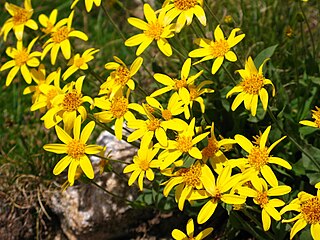
Packera werneriifolia, known by the common names alpine rock butterweed and hoary groundsel, is a species of flowering plant in the aster family. It is native to the western United States in the Sierra Nevada mountain habitat in subalpine and alpine climates, including forests and barren talus.

Nestotus stenophyllus is a species of flowering plant in the family Asteraceae known by the common name narrowleaf mock goldenweed. It was previously known as Stenotus stenophyllus. It is native to the western United States, especially the inland Pacific Northwest and northern Great Basin, where it grows in sagebrush habitat usually in rocky soil.
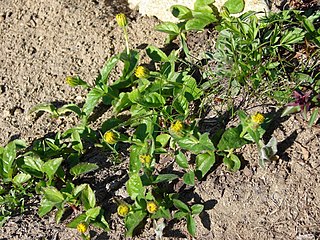
Tonestus lyallii is a species of flowering plant in the family Asteraceae known by the common names Lyall's goldenweed, Lyall's serpentweed and Lyall's tonestus. It is native to western North America, particularly in the Rocky Mountains and the mountain ranges of the Pacific Northwest with scattered occurrences between. It is a perennial herb growing in clumps or short bunches not more than about 15 centimeters tall, the stem branching from a tough caudex. The leaves are smooth-edged and linear or lance-shaped, the largest at the base of the plant reaching up to about 8 centimeters long. The inflorescence is a single flower head or a pair of heads each about a centimeter wide with green or red phyllaries. The head bears at least 10 or 11 bright yellow ray florets around a center containing many tubular disc florets.
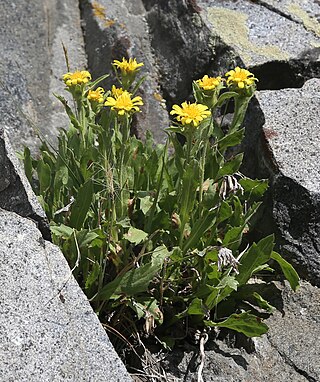
Tonestus peirsonii is a local-endemic species of flowering plant in the family Asteraceae known by the common names Inyo tonestus, Peirson's serpentweed and Peirson's tonestus.
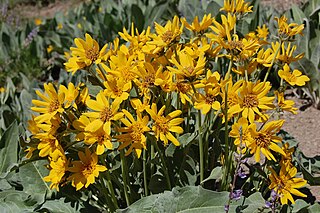
Wyethia mollis is a species of flowering plant in the family Asteraceae known by the common name woolly mule's ears. The plant is hairy to woolly in texture, sometimes losing its hairs with age.
Toiyabea alpina, the alpine serpentweed, is a species of North American plants in the tribe Astereae within the family Asteraceae. It is native to the Toiyabe and Toquima Mountains of central Nevada.

Eurybia kingii is a North American species of flowering plants in the family Asteraceae, called the King's serpentweed or King's aster. It has been found only in the State of Utah in the western United States.













